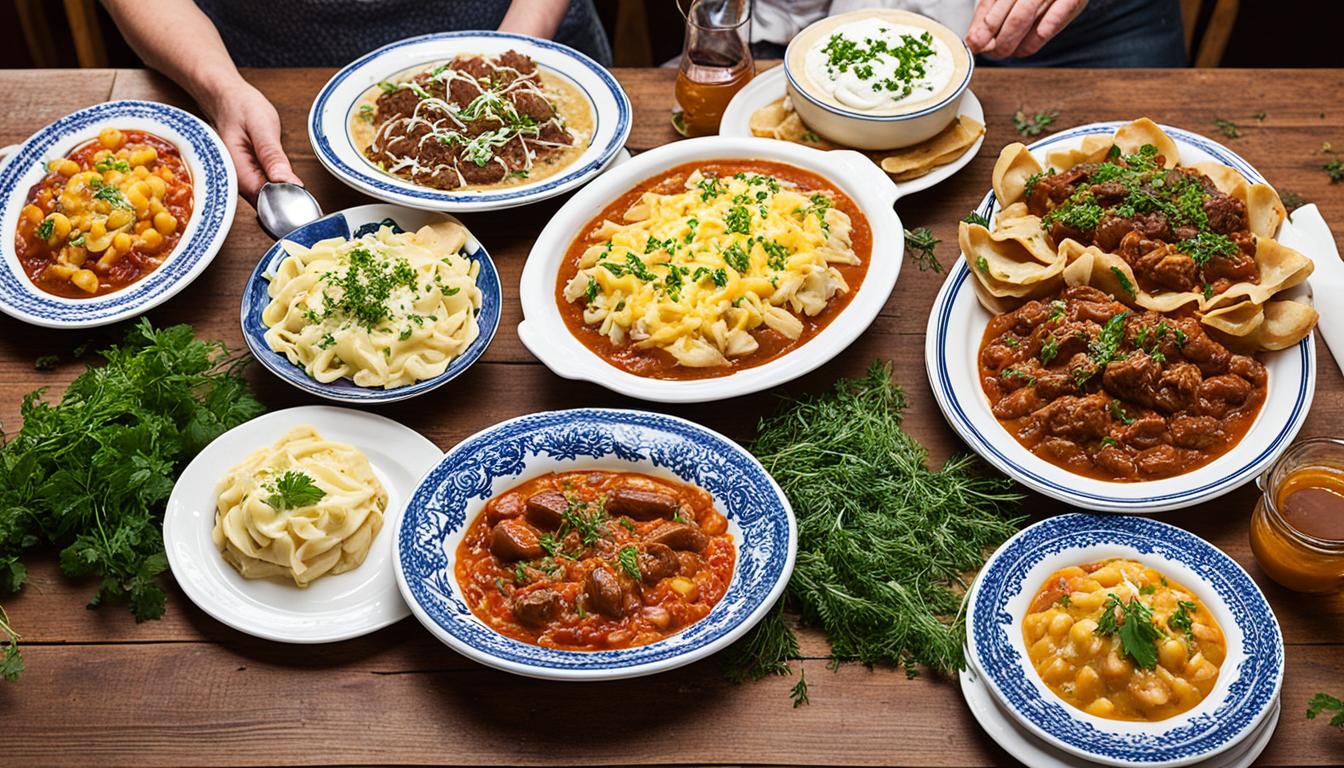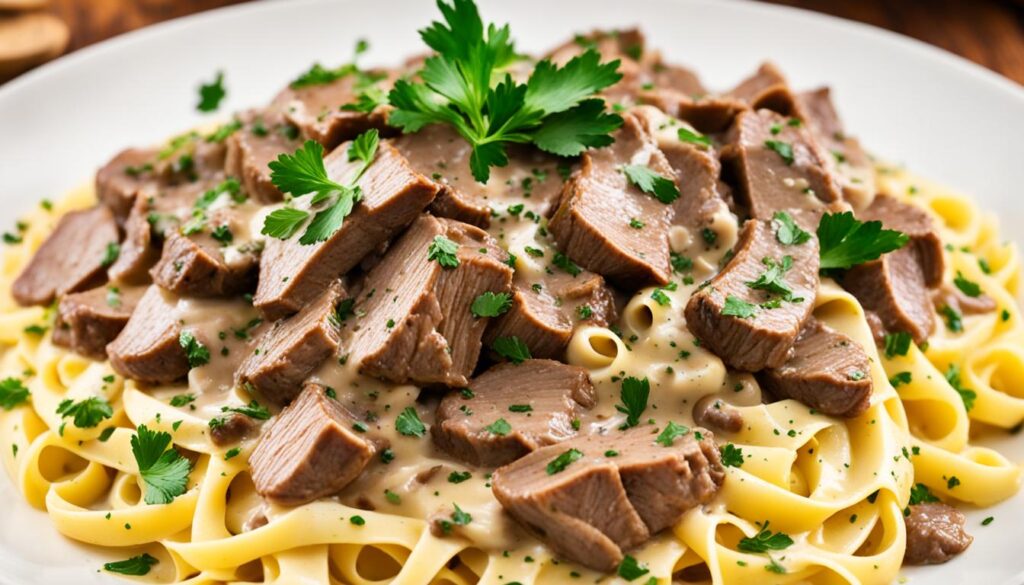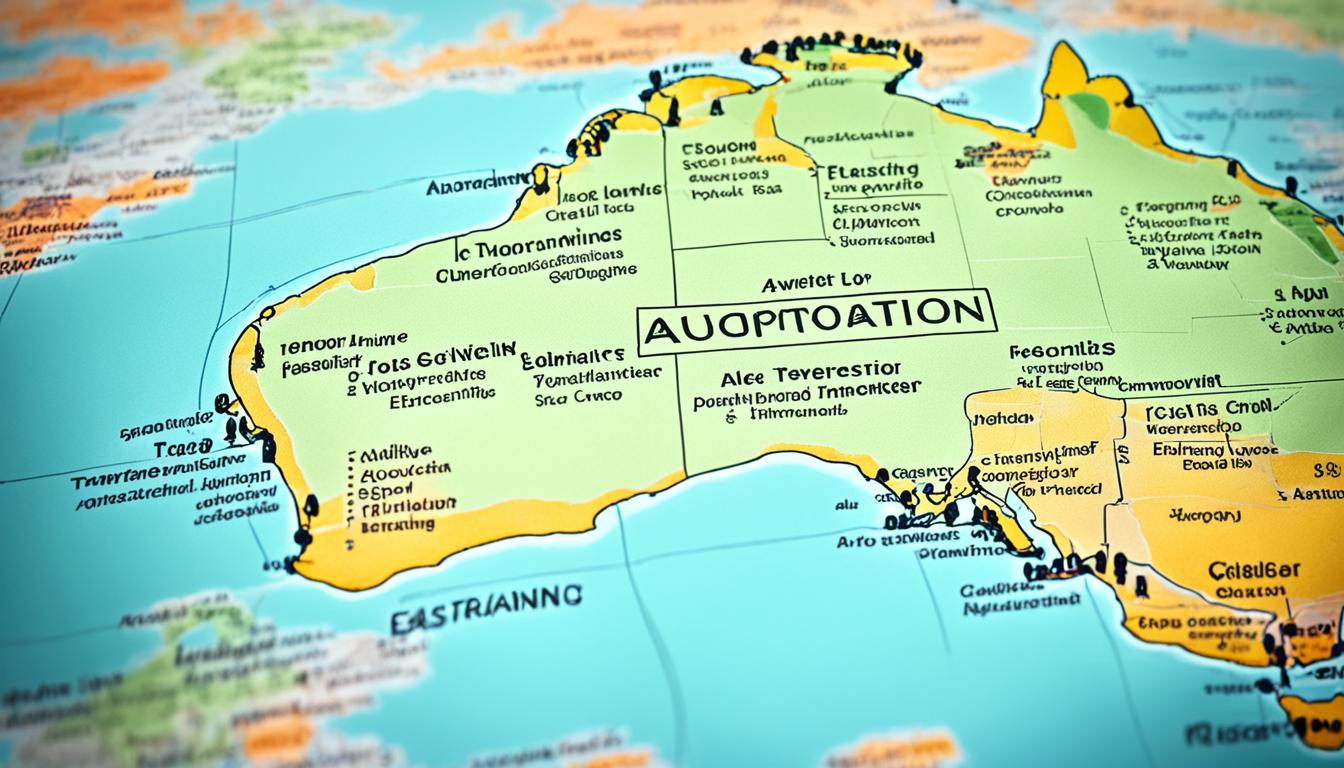
Eastern European cuisine is a culinary treasure trove, offering a diverse range of flavors and dishes that will tantalize your taste buds. From the hearty comfort foods of Russian cuisine to the savory delights of Polish food and the rich flavors of Hungarian cuisine, Eastern European food is a celebration of tradition, heritage, and the love of good food.
Slavic cuisine, known for its rustic charm and abundance of wholesome ingredients, forms the backbone of Eastern European food. Traditional dishes like borscht, a vibrant beet soup, and pierogi, delicious dumplings filled with various savory fillings, have been enjoyed for generations.
Key Takeaways:
- Eastern European cuisine offers a diverse range of flavors and dishes.
- Slavic cuisine forms the backbone of Eastern European food.
- Borscht and pierogi are traditional Eastern European dishes.
- Russian, Polish, and Hungarian cuisines are known for their distinctive flavors and ingredients.
- Exploring Eastern European food allows you to experience the rich culinary heritage of the region.
Cornmeal: A Staple Ingredient in Eastern European Cuisine
When it comes to the vibrant and diverse culinary traditions of Eastern European cuisine, one ingredient stands out as a staple in countless traditional dishes: cornmeal. This versatile ingredient plays a vital role in the region’s beloved recipes, offering a nourishing foundation and a canvas for culinary creativity.
Eastern European cuisine has a deep connection with cornmeal, utilizing it in a variety of ways. From hearty breads and dumplings to comforting porridges and fritters, cornmeal adds a distinct texture, flavor, and versatility to traditional dishes. Its availability and resilience in the region’s climate and agricultural practices have made it an essential component of Eastern European cooking.
Whether it’s the beloved Ukrainian banosh, Romanian mămăligă, or Serbian proja, cornmeal takes center stage, providing a comforting and satisfying experience. This ingredient not only infuses dishes with a rich, earthy flavor but also provides a delightful contrast of textures that adds depth to the overall dining experience.
The use of cornmeal in Eastern European cuisine extends beyond traditional dishes. In recent years, chefs and home cooks have embraced modern twists on classic recipes, combining cornmeal with unexpected flavors and ingredients. This fusion of cuisines brings a contemporary edge to Eastern European cornmeal dishes, attracting a new wave of food enthusiasts while still honoring the region’s culinary heritage.
Whether you’re new to Eastern European cuisine or a seasoned aficionado, exploring the world of cornmeal-based dishes is an exciting and delicious journey. The versatility of this ingredient will captivate your taste buds and open your palate to the rich tapestry of flavors that Eastern European cuisine has to offer.
So why not give it a try? Dive into the world of Eastern European cuisine and discover the wonders of cornmeal, a beloved and indispensable ingredient in traditional dishes that have captivated generations.
The Savory Richness of Romanian Mămăligă
Mămăligă, a beloved traditional dish in Romanian cuisine, is a cornmeal-based staple that embodies the simplicity, warmth, and rich flavors of this culinary tradition.
When it comes to mămăligă, the consistency can vary, ranging from soft and spoonable to firm and sliceable. This diversity allows for different culinary experiences and makes mămăligă a versatile addition to any meal.
Often served as the centerpiece of a Romanian feast, mămăligă is accompanied by delightful condiments and toppings that elevate its taste. Sour cream, tangy feta cheese, or sizzling bacon or sausage are popular choices that complement the flavors of this dish.
Whether enjoyed as a side dish, a main course, or even as a comforting snack, mămăligă showcases the heart of Romanian cuisine. Its savory richness and comforting qualities make it a beloved traditional dish that has stood the test of time.
“Mămăligă is a testament to the creativity and resourcefulness of Romanian culinary traditions. Its humble ingredients and flavors speak volumes about the culture and heritage of this beautiful country.”
The Hearty Simplicity of Ukrainian Banosh
When it comes to Ukrainian cuisine, few dishes capture the heartiness and simplicity quite like banosh. This traditional dish is a staple in Ukrainian households, offering a comforting and satisfying meal that has been enjoyed for generations.
To make banosh, cooks start by slowly cooking cornmeal in salted water or milk until it reaches a creamy, porridge-like consistency. This process allows the cornmeal to absorb the flavors of the liquid, resulting in a rich and comforting dish that warms both the body and soul.
To enhance the flavor and texture of banosh, it is commonly served with a dollop of sour cream and topped with shards of salty, smoked cheese. This combination adds a creamy tang and a smoky depth that elevates the dish to new heights.
Ukrainian banosh is a versatile dish that can be enjoyed on its own or paired with a variety of toppings and accompaniments. Some popular additions include mushrooms, fried onions, bacon, or even fresh herbs. This allows each individual to customize their banosh to their own liking, making it a truly personal and unique dining experience.
Whether served as a hearty breakfast, a satisfying lunch, or a comforting dinner, banosh is a dish that brings people together. It represents the warmth of Ukrainian hospitality and the rich culinary traditions that have been passed down through generations.
Experience the Comfort of Ukrainian Banosh with this Traditional Recipe:
Banosh Recipe
- Bring salted water or milk to a gentle boil in a saucepan.
- Add cornmeal gradually, stirring constantly to avoid lumps.
- Cook over low heat, stirring frequently, until the mixture thickens to a porridge-like consistency, approximately 20-30 minutes.
- Remove from heat and let it rest for a few minutes.
- Serve hot with a dollop of sour cream and generously sprinkle smoked cheese on top.
| Ingredients | Instructions |
|---|---|
| Cornmeal | 1 cup |
| Salt | 1 teaspoon |
| Water or Milk | 4 cups |
| Sour Cream | As desired |
| Smoked Cheese | As desired |
Now that you have the recipe, it’s time to embrace the hearty simplicity of Ukrainian banosh. Prepare this traditional dish in your own kitchen and savor the flavors that have been cherished by Ukrainians for centuries. Whether enjoyed as a comforting meal on a cold winter’s day or a delicious twist for brunch, banosh is sure to delight your taste buds and transport you to the heart of Ukrainian cuisine.
The Warming Flavors of Serbian Proja
Proja is a beloved traditional dish that represents the heartwarming flavors of Serbian cuisine. Derived from a mixture of cornmeal, water, and salt, this mouthwatering cornbread is enriched with sunflower oil and sometimes white cheese. The combination of simple ingredients produces a versatile dish that can be served as a delightful accompaniment to stews or savored on its own.
Proja pays homage to the rich culinary heritage of Serbia, showcasing the country’s commitment to flavorful and comforting traditional dishes. The cornbread’s golden hue and rustic texture capture the essence of Serbian cuisine, reflecting a prideful cultural appreciation for simplicity and depth of flavor.
Proja Recipe:
- In a large bowl, combine 2 cups of cornmeal, 1½ cups of water, and a pinch of salt.
- Gradually add ¼ cup of sunflower oil and mix until well combined.
- If desired, crumble ½ cup of white cheese into the mixture and incorporate gently.
- Pour the batter into a greased baking dish and spread evenly.
- Bake in a preheated oven at 375°F (190°C) for 20-25 minutes or until golden brown.
- Remove from the oven and let cool for a few minutes before slicing and serving.
“Proja is more than just a cornbread. It is a culinary expression of Serbian tradition, blending rustic simplicity with the warmth of homemade comfort food.”
Discover the joy of Serbian cuisine by indulging in the delightful flavors of Proja. This traditional dish serves as a testament to the deep-rooted culinary heritage of Serbia, offering a taste of history and a comforting meal for any occasion.
Contemporary Takes on Eastern European Cornmeal Classics
Eastern European cornmeal classics have stood the test of time, but that doesn’t mean they can’t be given a modern twist. Chefs and home cooks alike are reimagining traditional cornmeal dishes and infusing them with exciting flavors from around the world. This fusion cuisine approach adds new dimensions to Eastern European gastronomy, offering a unique and adventurous culinary experience.
One popular trend is incorporating health-conscious adaptations into these beloved recipes. By substituting certain ingredients with nutrient-dense alternatives and superfoods, these modern adaptations provide a healthier twist without sacrificing taste or culture.
Let’s take a closer look at some innovative examples of how Eastern European cornmeal classics are being reinvented:
1. Cornmeal Waffles with Avocado Salsa
This contemporary spin on a traditional Eastern European breakfast staple combines the light and crispy texture of cornmeal waffles with the creamy richness of avocado salsa. The combination of sweet and savory flavors offers a delightful contrast that will tantalize your taste buds.
“The fusion of Eastern European cornmeal waffles and avocado salsa creates a harmonious blend of flavors, taking your breakfast experience to a whole new level.” – Chef Maria Petrov
2. Buckwheat Cornmeal Fusion Dumplings
This fusion dish brings together the earthy and nutty flavors of buckwheat with the comforting texture of traditional cornmeal dumplings. The dumplings are filled with a delectable blend of ingredients, incorporating flavors from both Eastern European and Asian cuisines. Served with a tangy dipping sauce, these dumplings are a true culinary adventure.
3. Quinoa Cornbread with Roasted Vegetables
In this health-conscious adaptation, quinoa is used in place of some of the cornmeal, adding a protein-packed punch to the classic cornbread recipe. Roasted vegetables, such as bell peppers and zucchini, provide a burst of color and flavor, making this dish a hearty and nutritious option for any meal.
“Introducing quinoa and roasted vegetables into Eastern European cornbread elevates the dish to new heights, making it a satisfying and guilt-free indulgence.” – Chef Stefan Ivanov
| Cornmeal Dish | Modern Twist |
|---|---|
| Mămăligă | Served with seared mushrooms and truffle oil |
| Banosh | Topped with caramelized onions and melted cheese |
| Proja | Infused with spinach and feta cheese |
As you can see, Eastern European cornmeal dishes are being reimagined with modern twists and health-conscious adaptations. The resulting fusion cuisine pays homage to tradition while embracing new flavors and ingredients. Whether you’re a culinary adventurer or a health-conscious foodie, these contemporary takes on Eastern European classics are sure to delight your palate.
Tender Russian Blini
When it comes to Russian cuisine, one street food that stands out is tender blini. These delectable pancakes are filled with either sweet or savory fillings, making them a versatile choice for breakfast or a snack. Blini can be found in many Russian restaurants, where they are enjoyed by locals and visitors alike. With their crispy exterior and mouthwatering fillings, blini are a true representation of Russian culinary tradition.
If you’ve ever wanted to recreate the flavors of Russia in your own kitchen, here’s a simple blini recipe that you can try:
Classic Blini Recipe
- Ingredients:
- 1 cup all-purpose flour
- 1 cup milk
- 2 large eggs
- 2 tablespoons melted butter
- 1 tablespoon sugar
- 1/2 teaspoon salt
- Instructions:
- In a large bowl, whisk together the flour, sugar, and salt.
- In a separate bowl, beat the eggs and milk until well combined.
- Add the egg and milk mixture to the dry ingredients and whisk until smooth.
- Stir in the melted butter.
- Heat a non-stick skillet over medium heat and lightly grease with butter or oil.
- Pour a small amount of batter into the skillet and spread it out into a thin layer.
- Cook for 1-2 minutes, until the edges start to lift and the bottom is golden brown.
- Flip the blini and cook for an additional 1-2 minutes on the other side.
- Transfer the cooked blini to a plate and cover with a clean towel to keep warm.
- Repeat steps 6-9 with the remaining batter.
- Once all the blini are cooked, fill them with your favorite sweet or savory fillings.
- Serve warm and enjoy!
Whether you prefer a traditional filling like smoked salmon and sour cream or a sweet combination of berries and whipped cream, blini are sure to satisfy your cravings for Russian street food. So why not try your hand at making these tender pancakes and experience a taste of Russia in the comfort of your own home?

Braised Stuffed Cabbage
Stuffed cabbage, also known as holishkes or golubtzis, is a comforting dish that can be found in many Eastern European cuisines. It features silky cabbage leaves filled with savory fillings and is often served with deep-fried pickles and sausage. Stuffed cabbage is a versatile dish with many variations, making it a staple comfort food in Eastern European cuisine.
Whether you call it stuffed cabbage, holishkes, or golubtzis, this dish is a cherished staple in Eastern European cuisine. The combination of tender cabbage leaves and flavorful fillings creates a comforting and satisfying meal that is perfect for any occasion. While there are many variations of this dish across different countries, the essence of stuffed cabbage remains the same – a warm and delicious comfort food that brings joy to the table.
“Stuffed cabbage is like a warm hug on a plate. The tender cabbage leaves hold a mixture of seasoned meat and rice, creating a savory and comforting dish that is hard to resist.” – Natalia Ivanova, Eastern European Cuisine Expert
To make the perfect stuffed cabbage, start by carefully removing the outer leaves of a cabbage head and blanching them in hot water until they become pliable. Then, fill each leaf with a mixture of seasoned ground meat, rice, and aromatic ingredients like onions, garlic, and herbs. Roll the leaf tightly around the filling, ensuring it is sealed properly. Place the stuffed cabbage rolls in a pot, cover them with a flavorful tomato sauce, and let them simmer until they become tender and the flavors meld together.
The end result is a dish that is rich in flavor, with the sweetness of the cabbage complementing the savory filling. The comforting aroma that fills the kitchen as the stuffed cabbage cooks is enough to make anyone’s mouth water. It’s no wonder this dish is often passed down through generations, treasured as a family favorite.
Stuffed Cabbage Variations
While the classic stuffed cabbage recipe is hard to beat, there are several delicious variations to explore:
- Vegetarian Stuffed Cabbage: Replace the meat filling with a mixture of mushrooms, rice, and vegetables for a vegetarian twist.
- Sauerkraut Stuffed Cabbage: Add tangy sauerkraut to the filling or serve it as a side dish to enhance the flavors.
- Smoked Meat Stuffed Cabbage: Incorporate smoky flavors by using smoked meat, such as bacon or ham, in the filling.
Each variation offers a unique twist on the classic recipe, providing a range of flavors and textures to suit different palates.
Whether served as a main dish or as part of a festive meal, stuffed cabbage is a beloved comfort food that brings people together. Its hearty nature and satisfying flavors make it the ultimate comfort food for those seeking a taste of Eastern European cuisine.
Beautifully Smoked Sausages
When it comes to Russian and Polish cuisine, one culinary delight that stands out is the beautifully smoked sausages. These sausages are beloved for their smoky flavor and are a staple in both cuisines. The art of smoking sausages has been passed down through generations, resulting in a time-honored tradition that brings out rich and savory flavors.
In Russian cuisine, smoked sausages, or “kabanosy,” are made from a combination of pork and beef, seasoned with herbs and spices. They are then smoked to perfection, creating a robust and distinctive flavor that entices the taste buds. These sausages are often enjoyed on their own or served with pickles and braised cabbage, enhancing their smokiness with tangy and crunchy accompaniments.
Similarly, Polish cuisine showcases its love for smoked sausages with the famous “kiełbasa.” These sausages are made from high-quality meat, such as pork or beef, and carefully spiced to enhance their unique flavors. They are then smoked over natural wood, infusing them with a delightful smokiness that adds depth to every bite. Polish smoked sausages are often served with a side of sauerkraut and mustard, creating a perfect balance of flavors.
The Versatility of Smoked Sausages
One of the reasons why smoked sausages are so beloved is their versatility. They can be enjoyed in various ways and are suitable for different occasions. From informal gatherings to company events, these sausages never fail to impress. They can be served as part of a charcuterie board, added to stews and soups, or simply enjoyed on their own as an appetizer.
The smokiness of these sausages not only adds flavor but also acts as a natural preservative, allowing them to withstand sitting out at room temperature for extended periods without compromising their taste or quality. This quality makes them an ideal choice for outdoor parties or gatherings where food needs to be easily accessible throughout the event.
Savor the Flavors of Russian and Polish Cuisine
Smoked sausages are just one example of the many culinary delights that Russian and Polish cuisines have to offer. The flavors of these cuisines are deeply rooted in tradition and heritage, showcasing the richness and diversity of Eastern European gastronomy.
Whether you’re enjoying a Russian kabanosy or a Polish kiełbasa, the smokiness of these sausages will transport you to a world of delectable flavors and unforgettable culinary experiences. Indulge in the beauty of smoked sausages and savor the authentic taste of Russian and Polish cuisine.
Beef Stroganoff with Buttery Noodles
Indulge in the comforting flavors of Russian cuisine with this classic dish – Beef Stroganoff with Buttery Noodles. Known for its rich and hearty flavors, this recipe is sure to please and satisfy your taste buds.
Beef Stroganoff originated in Russia and has become a beloved comfort food around the world. The dish features tender quick-seared beef, tossed with buttery egg noodles, and smothered in a luscious sauce made from beef drippings and crème fraiche. The combination of flavors and textures creates a mouthwatering experience that is both satisfying and comforting.
Whether you’re hosting a dinner party or simply looking for a cozy meal to enjoy at home, Beef Stroganoff with Buttery Noodles is a perfect choice. Its creamy sauce and tender beef create a harmonious blend of flavors, making it a go-to dish for gatherings or office lunches and meetings.
Cooking this delicious comfort food is easier than you think. Follow the recipe below, and in no time, you’ll have a hearty and flavorful meal that is sure to impress:
Beef Stroganoff Recipe
- Ingredients:
- 1.5 pounds beef sirloin, thinly sliced
- 1 onion, thinly sliced
- 2 cloves garlic, minced
- 8 ounces crimini mushrooms, sliced
- 1 cup beef broth
- 1 cup crème fraiche
- 2 tablespoons Worcestershire sauce
- 2 tablespoons Dijon mustard
- 2 tablespoons butter
- Salt and pepper to taste
- 1 pound egg noodles, cooked according to package instructions
- Fresh parsley, chopped (for garnish)
- Instructions:
- In a large skillet, melt the butter over medium-high heat. Add the beef slices and cook until browned. Remove the beef from the skillet and set aside.
- In the same skillet, add the onion, garlic, and mushrooms. Cook until the onions are tender and the mushrooms have released their juices.
- Stir in the beef broth, crème fraiche, Worcestershire sauce, and Dijon mustard. Bring the mixture to a simmer and let it cook for 5 minutes, until the sauce has thickened.
- Return the beef slices to the skillet and cook for an additional 5 minutes, until the beef is cooked through and tender. Season with salt and pepper to taste.
- Serve the Beef Stroganoff over a bed of cooked egg noodles and garnish with fresh parsley. Enjoy!
Beef Stroganoff with Buttery Noodles is the epitome of comfort food. Its warm, rich flavors and tender beef make it a satisfying dish that will leave you feeling cozy and content. Whether you’re looking to impress your guests or simply enjoy a comforting meal at home, this classic Russian dish is sure to delight.

Tender Russian Blini
If you’re looking to experience the authentic flavors of Russian cuisine, look no further than tender Russian blini. These divine pancakes are a popular street food in Russia, enjoyed by locals and tourists alike. With their crispy exterior and delectable fillings, blini are the perfect choice for breakfast or a snack.
Traditionally, blini are made from a simple batter of flour, eggs, milk, and a pinch of salt. The batter is then poured onto a hot griddle and cooked until golden brown. Once cooked, the blini can be filled with a variety of sweet or savory ingredients, allowing for endless flavor combinations.
Popular sweet fillings for blini include fresh berries, jam, honey, or sweetened condensed milk. If savory is more your style, you might opt for fillings such as smoked salmon, cream cheese, caviar, or sautéed mushrooms. The versatility of blini makes them a crowd-pleasing option for any meal of the day.
When in Russia, you can find blini at local street food stalls, cafes, and restaurants. They are often served piping hot, making them a comforting treat on a cold day. Blini have become a symbol of Russian street food culture, showcasing the country’s rich culinary heritage.
Whether you’re enjoying a sweet or savory blini, the combination of the crispy pancake and flavorful filling is sure to leave you craving more. So why not try your hand at making these Russian delicacies at home? Below, we’ve provided a simple blini recipe for you to enjoy.
Blini Recipe
- In a mixing bowl, whisk together 1 cup of all-purpose flour, 1 teaspoon of baking powder, and a pinch of salt.
- In a separate bowl, beat 2 eggs and gradually add 1 cup of milk while whisking continuously.
- Pour the wet ingredients into the dry ingredients and whisk until smooth.
- Heat a non-stick skillet over medium heat and brush with a small amount of vegetable oil.
- Pour about 1/4 cup of batter onto the skillet and spread it into a thin, circular shape.
- Cook the blini for 1-2 minutes on each side, or until golden brown.
- Remove from the skillet and repeat with the remaining batter.
- Fill the blini with your choice of sweet or savory fillings.
Enjoy these homemade blini as a delicious representation of Russian street food and immerse yourself in the flavors of Russian cuisine.
Contemporary Takes on Eastern European Cornmeal Classics
Eastern European cornmeal classics are not immune to the evolving culinary trends of today. Creative chefs and home cooks are experimenting with modern twists, infusing these traditional cornmeal dishes with new flavors and techniques. From fusion cuisine to health-conscious adaptations, these contemporary takes on Eastern European classics offer a fresh and exciting culinary experience while still honoring the rich flavors and traditions of the region.
One popular trend in modern Eastern European cuisine is the fusion of traditional dishes with other culinary influences. Chefs are combining cornmeal with unexpected ingredients and flavors from around the world, creating unique and innovative dishes that pay homage to the region’s culinary heritage while adding a modern twist. For example, cornmeal is now being paired with spices and ingredients commonly found in Mexican or Asian cuisine, resulting in fusion creations that delight the taste buds and broaden the culinary horizon.
Health-conscious adaptations are also on the rise, as people become more aware of the importance of nutritious and balanced meals. Chefs and home cooks are incorporating nutrient-dense ingredients and superfoods into cornmeal dishes, making them not only delicious but also beneficial for one’s well-being. By adding ingredients like kale, quinoa, or chia seeds to cornmeal recipes, they bring a modern, health-conscious twist to traditional Eastern European cuisine.
Moreover, these contemporary takes on Eastern European cornmeal classics present an opportunity to explore a wide range of textures and flavors. Chefs are experimenting with different cooking techniques, such as grilling, baking, or pan-searing, to bring out the unique qualities of cornmeal. From crispy cornbread croutons to creamy polenta with a flavorful topping, the possibilities are endless.
Whether you’re a traditionalist or an adventurous food lover, these modern twists on Eastern European cornmeal dishes provide a delightful culinary journey that merges tradition with innovation. By embracing fusion cuisine and health-conscious adaptations, these contemporary takes honor the roots of Eastern European cuisine while embracing the ever-changing world of food and flavors.
Conclusion
Eastern European food is a treasure trove of enticing flavors and a testament to the region’s rich culinary heritage. From the versatile and humble cornmeal to beloved traditional dishes like mămăligă, banosh, and proja, this cuisine showcases the resilience, creativity, and cultural significance of Eastern European communities.
Whether you’re indulging in classic recipes handed down through generations or exploring modern twists on traditional dishes, Eastern European food offers a delightful gastronomic experience. Sample the authentic flavors of borscht, pierogi, and other traditional Eastern European dishes to truly appreciate the depth and diversity of this unique culinary tradition.
The culinary heritage of Eastern European cuisine is an embodiment of the history, traditions, and customs of the region’s diverse communities. Through its flavors, Eastern European food tells stories of resilience, celebration, and cultural exchange. Every dish carries the essence of its people, providing a glimpse into the vibrant tapestry of Eastern European culinary traditions.
As you savor the delicious flavors of Eastern European food, you not only indulge your taste buds but also pay homage to the centuries-old culinary heritage of this remarkable region. So, embrace the captivating journey through Eastern European cuisine and immerse yourself in a culinary experience that is sure to leave you craving for more of its authentic and traditional delights.







